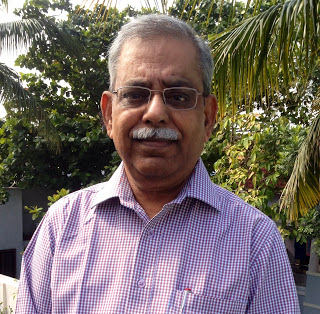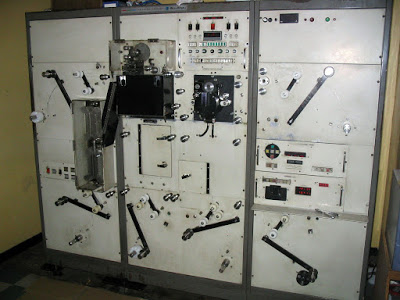My Journey with films
Shri S.Sivaraman
(Technical head of Prasad Film Laboratories Chennai)
MY JOURNEY WITH FILMS: S.SIVARAMAN (TECHNICAL HEAD OF PRASAD FILM LABORATORIES CHENNAI)
Aug 24 2016
Here, he shares his rich experiences with SICA:
Early Career
I did my graduation in physics at Scot Christian college, Nagercoil and came to Chennai for pursuing a diploma in film technology specializing in film processing at Adyar Film Institute. And then, I moved to Mumbai to work in Bombay film industry and joined one of the reputed labs called M/S Famous Cine Laboratories there. I worked for three years in the Black and White section and then was shifted to the color department. At Famous, I got opportunity to work in various departments and familiarize with various formats like 35mm, 16mm, 35mm to 16mm reduction etc…both in color and B&W.

At that time, it was subtractive system of grading which is a difficult and also a time consuming process. The graders has to coordinate the work from highly skilled technicians like band makers, markers, notch cutters, printers and developers to carry out his job of color correction. Those days it takes nearly 3 to 4 weeks to complete the grading / color balancing of a full length feature film.
Black and White to Color Film
In a color film the separation is provided by the colors, hence the depth is perceived easily where as Black and White films has only two tones hence one has to handle shadows, highlights and the middle tones with greater care to get depth. For the same reason lighting for B&W photography is considered to be more challenging.
In B&W, the grader has to judge the shadows, high lights and middle tones properly and time the scenes or shots so that you get the right densities which create the depth and contrast required for it or match the original scene shot as the case may be.
It is particularly tricky to time night scenes as great expertise and subjective judgment is required to bring proper depth without losing shadow details. If it is a well graded film, it brings out lighting, the original exposure to the best possible level so that we get a good depth in the final projection. Those days the graders were called as timers and the Cinematographers sit with them to get the best out of their work from the lab.
Subtractive System of colors and Lilly
During those days, while filming, the cameramen expose few frames extra than actually needed at the end of every shot which is called as Lilly. After film is processed and final editing is done negative cutting starts. At this stage the editor will pick up two frames from the end portion of each shot and makes it in a roll form. Before making the final print, for the sake of color grading, we print these Lillies first to make the best possible print which is called “one light print”.
Small bits of color correction gel filters of YMC (Yellow, Magenta, Cyan) were used to filter out the unwanted excess colors which are there invariably due to various unavoidable factors which could not be corrected or controlled during shooting (like exposure, change in lighting condition, change in color temperature of the light source, change of stock, storage , processing condition etc).
In this way each and every shot is color corrected and the process is repeated several rounds till the perfect color balance is achieved as required by the Cinematographer.

Relationship with Cinematographers
I would like to stress the point that any laboratory committed to quality and believe in delivering goods should consider the Cinematographer as the most important visitor to its premises. In fact, it is his second working place away from his shooting place. Even when the cameraman is shooting hundreds of kilometers away in far flung areas, the laboratory works for him.
A good lab technician should constantly endeavor to live up to the expectations of the Cinematographer. He is a store house of knowledge about exposure levels and the kind of negative / Print densities required to get the right kind of visual as the laboratory is an unique place where its technicians gets the wonderful opportunity of seeing or going through millions of feet negatives exposed by Cinematographers of various caliber & competence and knowing their working styles in achieving the final result.
Whatever I am today, I owe it to the management of Prasad film laboratories, Mr. Ramesh Prasad, our managing director for providing a wonderful opportunity to serve this industry and particularly to the community of Cinematographers, dedicated directors in their pursuit of excellence in image quality.
Prasad is always in the fore front of technology and introduced many things for the first time in the country which gave me challenging moments, to learn from mistakes, hone my skills and make progress.
Prasad lab is a pioneer to take a leap in technology by introducing additive System of Printing in conjunction with Electronic Colour Analyzer which made the job of colour correction less complicated, simple and fast.
Lillies and CC filters are no longer required. The computer system connected to the Analyzer grabs the RGB ( RED, GREEN BLUE ) & FCC ( Frame Count Cueing) data which when fed to the printing machine by floppy interface the micro processor inside actuate the light valves automatically and colour balances the scenes seamlessly and accurately.
Of course the crucial RGB data of each scene which determines the final look of the scene on the screen is the subjective judgment of the Grader which is influenced by the right inputs from the Cinematographer. The advantages of additive system of color correction made it possible to complete the color balancing of an entire feature film within 48 hours where it used to take 2 to 3 weeks in the Subtractive system.
At Prasad we handled almost all formats of film like 16mm, 35mm and 70mm including inter format conversions like 35mm to 16mm reduction, 16mm to 35mm blow up, Anamorphic to flat etc.
For the first time in India we introduced printing & processing of 70mm release prints with magnetic striping and 6 tracks stereophonic transfers for which our producers had to go abroad till then. We were also the first laboratory to introduce printing and processing of Dolby SR / Dolby Digital / DTS sound formats and 3D release prints. All these are made possible in our effort to meet the ever increasing demand of our discerning customers who want to excel in their chosen area of creative endeavour.
DIGITAL FILM MAKING
It is sad that the 150 year old photo chemistry based film technology known as the most elegant and efficient medium for image capturing, recording, projection, storage and preservation is being phased out and almost becoming extinct. But nobody can stop the onslaught of new technology which temporarily affects the life of a section of the people but is good for the progress and benefits the people over all.
In that sense it is a welcome change and we need to adapt to it. There are great advantages in Digital Technology / Digital film making. First and foremost it is efficient, faster and very cost effective. The digital data is extremely flexible hence image manipulation (while doing complicated VFX shots) becomes simple and affordable.
Data can be shared in different work stations which are geographically apart so that greater amount of work can happen simultaneously thus cutting post production time. Inter format change is less complicated and simple hence it is easy to merge footages shot with different cameras (film or digital) with wide variations in resolution, sharpness and aspect ratios.
Last but not the least slicing and resizing of the image makes deliverables easy for various media across all platforms like Cinema, Television, Cable, Palm fitting devices like Mobile, Internet and web casting and so on.
On the flip side, the hardware becomes outdate very fast, the formats are not fully standardized, work flows in post is becoming complicated, tendency to shoot more thus ending up with huge data to handle in the post, increase investment in hard disk and other devices for backup and storage and there is also data security concerns.
As the image is handled at innumerable work stations by different set of people there is comparatively less ownership and control over final quality of the image. But let us be optimistic about these drawbacks are temporary and when the easy go attitude of ‘Let’s fix it in the Post’ fades away and professionalism catches up.
In the final analysis, I find the humble Timer of the B&W era who has spent his days looking intensively at the film in his illuminated rewinding table assumed the name of Grader when he traveled to the age of new Additive System. He then sat through the Electronic Color Analyzer manipulating the RGB controls. Then came digital era where he progressed to occupy the chair with the consoles (digital suits) sophisticated work stations like Luster or Base Light with innumerable buttons and controls to enable tools like power window, secondary color correction, degraining, sharpening and so on. He is known as the Colorist.
But the job profile of the Timer or Grader or Colorist practically remains the same. Their basic skill sets, aesthetic sense and sensibilities and most importantly the ability to deliver the final image quality to the full satisfaction of the Cinematographer remains the same as long as the passion and commitment to quality of the individual remains unchanged.
Motion picture film stock as recording medium exists in major Hollywood productions and even few low budget Independent filmmakers from Europe still prefer to shoot in film.
I foresee the revival of motion picture film stock as recording medium in India soon. Then cinematographers have great liberty to shoot in both the formats (film and digital).
